被动语态的译法(12)
- 格式:doc
- 大小:68.00 KB
- 文档页数:5
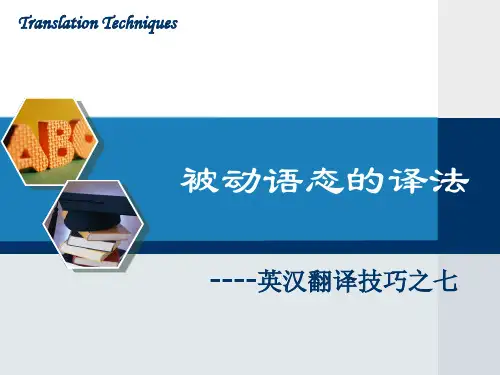

英语中被动句的翻译⽅法(1) 汉语中有被/由/叫/挨/让/给/受/遭等词时,可译成英语被动句.他常被派做这项⼯作. He is often sent to do this work.你叫⾬淋湿了. Have been wetted in the rain.这孩⼦昨天挨来了⼀顿批评. The boy was criticized yesterday.我们的⾐服给汗⽔湿透了. Our clothes were soaked with sweat.东西受潮了. The things have been affected with damp.他们去年遭了灾. They were hit by a natural calamity last year.(2) 不带标记的汉语被动句有些句⼦的主语不是动词的执⾏者,⽽是动作的承受者,结构上是主动的,但含义上确是被动的,英译时⽤被动句处理.历史是⼈民创造的. History is made by the people.这⾸歌是我⼀个朋友谱写的. The song was composed by a friend of mine.这个问题必须予以处理. This matter must be dealt with.这座桥将在今年年底建成.The construction of the bridge will be completed by the end of this year.(3) 汉语某些习语的译法:有些汉语习语,语态上是主动的,但英译时要⽤被动语态,特别是英语中以IT作形式主语的句式.应该说,基本情况是健康的. It should be said that the situation is basically sound.据报,敌⼈当时离那⾥只有⼗⾥.It is reported that the enemy were ten li away.很明显,这计划应当取消. It is obvious that the plan should be scrapped.据谣传,那场事故是由于玩忽职守⽽造成的. It is rumored that the accident was due to negligence.据了解这地⽅有丰富的⾃然资源. It is known that the area is rich in natural resources.有⼈认为 It is considered that-- 普遍认为 It is generally accepted that--据信 It is believed that-- 众所周知 It is well known that据悉 It is learned that 据推测 It is supposed that--据估计 It is estimated that 必须指出 It must be pointed out that可见 It will be seen that 不⽤说 It is understood that⽆可否认 It cannot be denied that 已经证明 It has been proved that可以肯定 It may be confirmed that 可以有把握地说 It may be safely said that⼈们有时会问 It is sometimes asked that ⼈们希望 It is expected that据说 It is said that据报道 It is reported that。
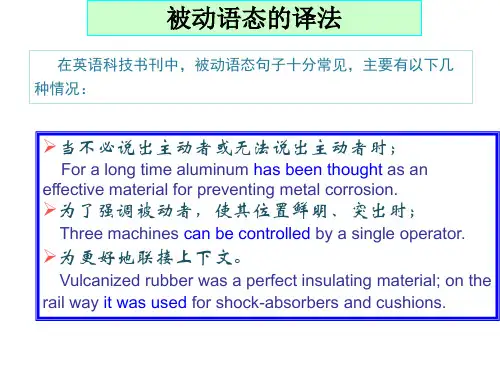
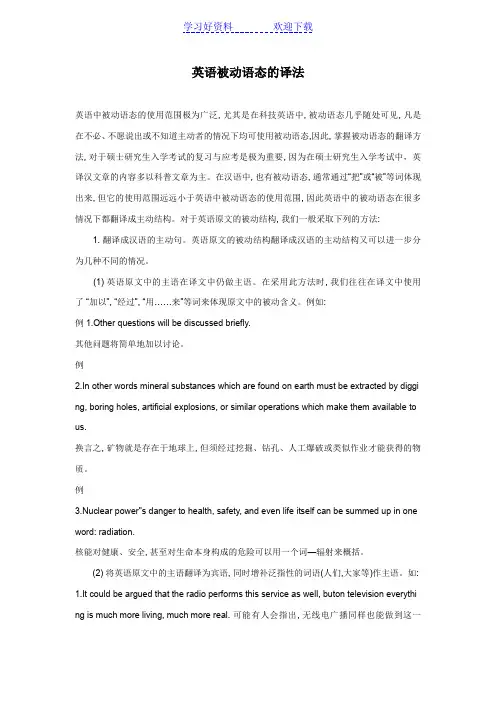
英语被动语态的译法英语中被动语态的使用范围极为广泛, 尤其是在科技英语中, 被动语态几乎随处可见, 凡是在不必、不愿说出或不知道主动者的情况下均可使用被动语态,因此, 掌握被动语态的翻译方法, 对于硕士研究生入学考试的复习与应考是极为重要, 因为在硕士研究生入学考试中,英译汉文章的内容多以科普文章为主。
在汉语中, 也有被动语态, 通常通过“把”或“被”等词体现出来, 但它的使用范围远远小于英语中被动语态的使用范围, 因此英语中的被动语态在很多情况下都翻译成主动结构。
对于英语原文的被动结构, 我们一般采取下列的方法:1. 翻译成汉语的主动句。
英语原文的被动结构翻译成汉语的主动结构又可以进一步分为几种不同的情况。
(1) 英语原文中的主语在译文中仍做主语。
在采用此方法时, 我们往往在译文中使用了“加以”,“经过”,“用……来”等词来体现原文中的被动含义。
例如:例1.Other questions will be discussed briefly.其他问题将简单地加以讨论。
例2.In other words mineral substances which are found on earth must be extracted by diggi ng, boring holes, artificial explosions, or similar operations which make them available to us.换言之, 矿物就是存在于地球上, 但须经过挖掘、钻孔、人工爆破或类似作业才能获得的物质。
例3.Nuclear power"s danger to health, safety, and even life itself can be summed up in one word: radiation.核能对健康、安全, 甚至对生命本身构成的危险可以用一个词—辐射来概括。
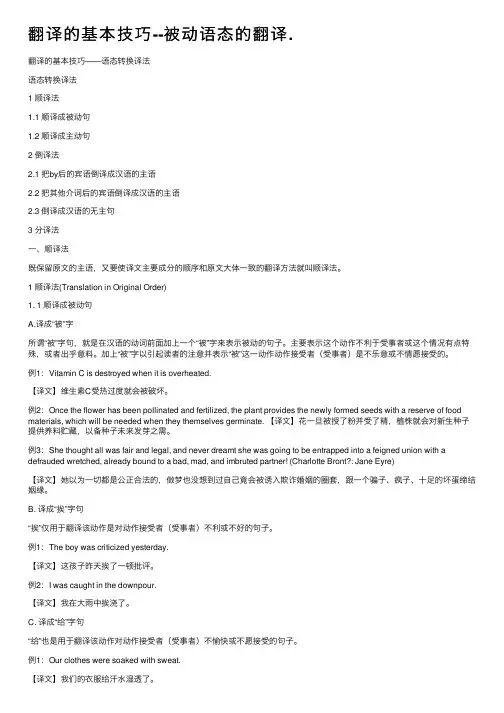
翻译的基本技巧--被动语态的翻译.翻译的基本技巧——语态转换译法语态转换译法1 顺译法1.1 顺译成被动句1.2 顺译成主动句2 倒译法2.1 把by后的宾语倒译成汉语的主语2.2 把其他介词后的宾语倒译成汉语的主语2.3 倒译成汉语的⽆主句3 分译法⼀、顺译法既保留原⽂的主语,⼜要使译⽂主要成分的顺序和原⽂⼤体⼀致的翻译⽅法就叫顺译法。
1 顺译法(Translation in Original Order)1. 1 顺译成被动句A.译成“被”字所谓“被”字句,就是在汉语的动词前⾯加上⼀个“被”字来表⽰被动的句⼦。
主要表⽰这个动作不利于受事者或这个情况有点特殊,或者出乎意料。
加上“被”字以引起读者的注意并表⽰“被”这⼀动作动作接受者(受事者)是不乐意或不情愿接受的。
例1:Vitamin C is destroyed when it is overheated.【译⽂】维⽣素C受热过度就会被破坏。
例2:Once the flower has been pollinated and fertilized, the plant provides the newly formed seeds with a reserve of food materials, which will be needed when they themselves germinate. 【译⽂】花⼀旦被授了粉并受了精,植株就会对新⽣种⼦提供养料贮藏,以备种⼦未来发芽之需。
例3:She thought all was fair and legal, and never dreamt she was going to be entrapped into a feigned union with a defrauded wretched, already bound to a bad, mad, and imbruted partner! (Charlotte Bront?: Jane Eyre)【译⽂】她以为⼀切都是公正合法的,做梦也没想到过⾃⼰竟会被诱⼊欺诈婚姻的圈套,跟⼀个骗⼦、疯⼦、⼗⾜的坏蛋缔结姻缘。
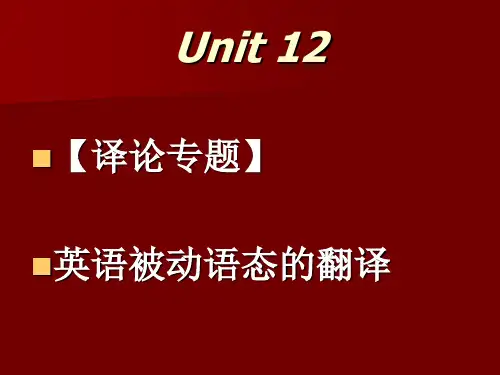
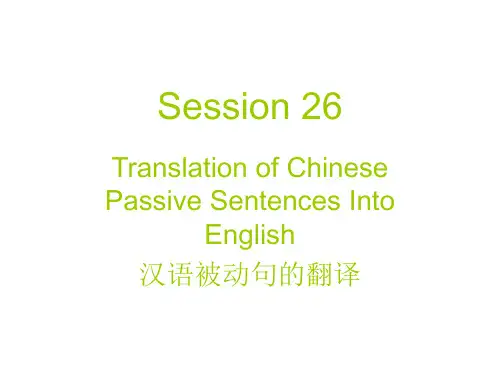
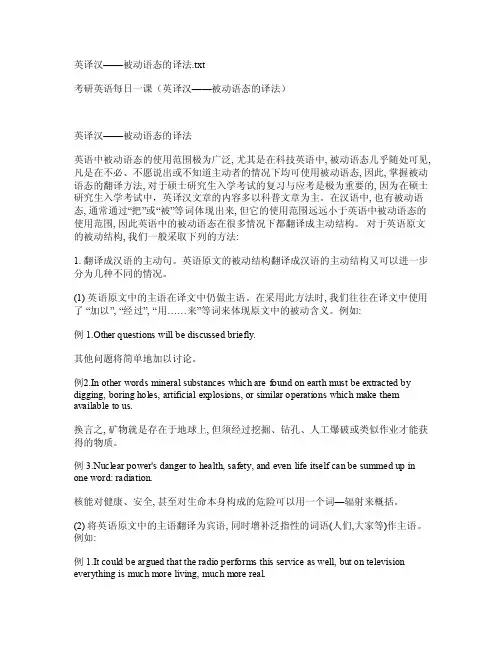
英译汉——被动语态的译法.txt考研英语每日一课(英译汉——被动语态的译法)英译汉——被动语态的译法英语中被动语态的使用范围极为广泛, 尤其是在科技英语中,被动语态几乎随处可见, 凡是在不必、不愿说出或不知道主动者的情况下均可使用被动语态, 因此, 掌握被动语态的翻译方法,对于硕士研究生入学考试的复习与应考是极为重要的,因为在硕士研究生入学考试中,英译汉文章的内容多以科普文章为主。
在汉语中, 也有被动语态,通常通过“把”或“被”等词体现出来, 但它的使用范围远远小于英语中被动语态的使用范围, 因此英语中的被动语态在很多情况下都翻译成主动结构。
对于英语原文的被动结构, 我们一般采取下列的方法:1.翻译成汉语的主动句。
英语原文的被动结构翻译成汉语的主动结构又可以进一步分为几种不同的情况。
(1) 英语原文中的主语在译文中仍做主语。
在采用此方法时, 我们往往在译文中使用了“加以”, “经过”, “用……来”等词来体现原文中的被动含义。
例如:例1.Oth er qu estio ns wi ll be disc ussed brie fly.其他问题将简单地加以讨论。
例2.In o therwords mine ral s ubsta nceswhich arefound on e arthmustbe ex tract ed bydigg ing,borin g hol es, a rtifi cialexplo sions, orsimil ar op erati ons w hichmakethemavail ableto us.换言之, 矿物就是存在于地球上,但须经过挖掘、钻孔、人工爆破或类似作业才能获得的物质。

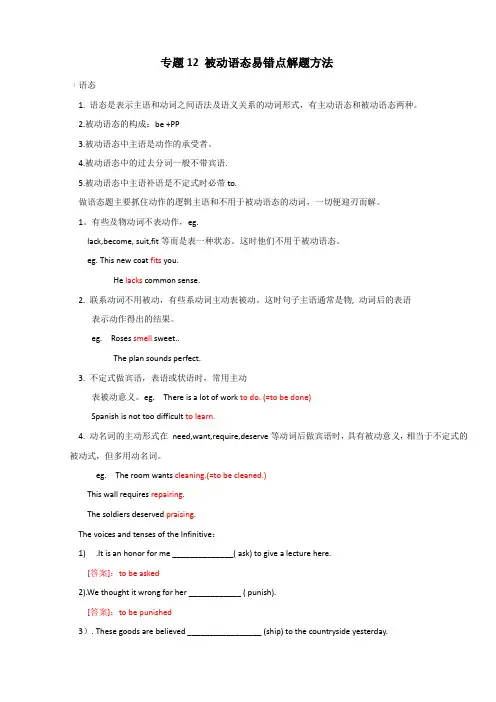
专题12 被动语态易错点解题方法语态1. 语态是表示主语和动词之间语法及语义关系的动词形式,有主动语态和被动语态两种。
2.被动语态的构成:be +PP3.被动语态中主语是动作的承受者。
4.被动语态中的过去分词一般不带宾语.5.被动语态中主语补语是不定式时必带to.做语态题主要抓住动作的逻辑主语和不用于被动语态的动词,一切便迎刃而解。
1。
有些及物动词不表动作,eg.lack,become, suit,fit等而是表一种状态。
这时他们不用于被动语态。
eg. This new coat fits you.He lacks common sense.2. 联系动词不用被动,有些系动词主动表被动。
这时句子主语通常是物, 动词后的表语表示动作得出的结果。
eg. Roses smell sweet..The plan sounds perfect.3. 不定式做宾语,表语或状语时,常用主动表被动意义。
eg. There is a lot of work to do. (=to be done)Spanish is not too difficult to learn.4. 动名词的主动形式在need,want,require,deserve等动词后做宾语时,具有被动意义,相当于不定式的被动式,但多用动名词。
eg. The room wants cleaning.(=to be cleaned.)This wall requires repairing.The soldiers deserved praising.The voices and tenses of the Infinitive:1).It is an honor for me ______________( ask) to give a lecture here.[答案]:to be asked2).We thought it wrong for her ____________ ( punish).[答案]:to be punished3). These goods are believed _________________ (ship) to the countryside yesterday.[答案]:to have been shipped4). Sorry _______________ ( not give ) you so much help.[答案]:not to have given◆典型陷阱真题分析◆1. "Do you like the material?" "Yes, it _____ very soft."A. is feelingB. feltC. feelsD. is felt【答案】C.【解析】此题容易误选D,想当然地根据"这布料摸起来很柔软"这一句意,认为"布料"应是"被摸",所以feel 选用被动语态。

语态转换译法Translation of Passive Voice12-13-2010例如:As oil is found deep in the ground its presence cannot be determined by a study of the surface. Consequently, a geological survey of theunderground rock structure must be carried out . If it is thought that the rocks in a certain area contain oil, a“drilling rig drilling rig”” is assembled. The most obvious part of a drilling rig is called “a derrick a derrick””. 译文:因为石油深埋地下,所以单靠研究地面还不能确定有无石油储量。
因此,必须对地下岩层结构进行地质勘测。
如果认为某地域岩层含有石油,那就在该处安装“钻机”。
钻机中最显眼的部件叫做“井架”。
It is used to lift sections of pipe, which are lowered into the hole made by the drill. As the hole is being drilled, a steel pipe is pushed down to prevent the sides from falling in. If oil is struckstruck,, a cover is firmly fixed to the top of the pipe and the oil is allowed to escape through a series of valves. (John Swales: Writing Scientific English) . 续:井架用来升吊分节油管,把油管放入由钻头打出的孔隙中。
科技英语中被动语态的用法及译法孔爱娟英语中动词的特点是有时态、语态和语气的变化,而语态又有主动和被动之分。
主动语态的构成和翻译比较简单,容易掌握;被动语态的构成和翻译要相对复杂一些,掌握起来也有一定难度。
科技英语中被动语态的使用比率较高,这也是科技英语句法上的一个主要特点。
据统计,被动语态句子在科技英语文章中占三分之一的比例,比普通英语文章中被动语态句子出现的频率高一倍。
究其原因,是被动语态与主动语态相比,更能突出要说明的事物——动作对象,所以才在科技文章和科普作品中得到广泛使用。
科技英语是大学外语教学的主要内容,有鉴于此,掌握好科技英语中被动语态的用法及其译法是极其重要的。
基于多年教授科技英语的经验,本人对科技英语中被动语态的用法及其译法略有心得。
本着提高教学质量和效果的目的,本人在多年讲授经验的基础上,查阅了大量有关科技英语中关于被动语态的资料,对其进行了专题性研究,整理成文,以作探讨。
1 被动语态更能突出动作的对象科技文章中讨论的中心主要是动作的对象,而不是动作的执行者;为了突出中心,常使用被动语态;如果使用主动语态,不但句子结构繁琐,中心模糊,而且有时会造成读者对句意的误解。
例:例1. Computer is now widely used.. 目前计算机已被广泛应用。
例2. Now we use computer widely. 目前我们广泛应用计算机。
从以上两个例句可以看出:例1使用被动语态,突出动作的对象,使句子主题更加突出;例2虽然表达了同样的意思,主题却不够突出。
2 科技文章的定义、定理、原理等,大多没有动作的执行者,只有用被动语态来陈述例3. Memory is often defined as the ability to recall past events.人们常常把记忆定义为回忆过去事情的能力。
例4. The word “plastic” is used to describe something which is easily shaped. “塑料”一词被用来描述某种易于成型的东西。
英语被动语态的翻译在英语中,被动语态是一种常见的语法结构,表示主语被动作所影响或行为被执行。
在翻译被动语态时,我们需要考虑中文的表达方式和语言习惯,以便准确地传达原文的含义。
一、英语被动语态的构成英语被动语态由助动词be、动词的过去分词和主语组成。
助动词be 是被动语态的标志,它有现在时和过去时的形式,如is、are、was、were等。
动词的过去分词表示动作已经完成,如given、done、written 等。
主语是动作的接受者,通常在句子的开头。
二、英语被动语态的翻译技巧1、转换为主动语态中文习惯使用主动语态,因此在翻译英语被动语态时,我们可以将其转换为主动语态。
例如,“The book was written by John”可以翻译为“这本书是由约翰写的”。
2、添加“被”字中文中可以使用“被”字来表示被动关系。
在翻译英语被动语态时,我们可以添加“被”字来明确动作的接受者。
例如,“The car was hit by a bus”可以翻译为“这辆车被公交车撞了”。
3、使用“受”、“遭”等词除了使用“被”字外,中文还可以使用“受”、“遭”等词来表示被动关系。
例如,“The city was attacked by the enemy”可以翻译为“这个城市遭到了敌人的攻击”。
4、省略“被”字在一些情况下,中文可以省略“被”字,直接将主语作为动作的接受者。
例如,“The house was cleaned”可以翻译为“房子被打扫了”。
翻译英语被动语态时,我们需要根据中文的语言习惯和表达方式进行适当的调整,以便准确地传达原文的含义。
考研英语中被动语态的翻译技巧引言在考研英语中,被动语态是考生必须掌握的一个重要语法结构。
由于中英文的语言习惯差异,被动语态的翻译成为了很多考生的难点。
本文将详细讲解考研英语中被动语态的用法和特点,并介绍相应的翻译技巧,帮助考生更好地应对翻译中的挑战。
知识点讲解被动语态是英语中常见的语法结构之一,通常用于强调动作的承受者。
被动语态的译法(Translation of the Passive)英语中被动语态使用范围很广。
凡是在不必说出主动者、不愿说出主动者、无从说出主动者或者是为了便于连贯上下文等场合,往往都用被动语态。
汉语中虽也有被动语态,但使用范围狭窄得多。
英语被动语态的句子,译成汉语时,很多情况下都可译成主动句,但也有一些可以保持被动语态。
一、译成汉语主动句英语被动语态的句子译成汉语主动句可有几种不同情况:(一)原文中的主语在译文中仍为主语1)The whole country was armed in a few days.几天之内全国武装起来了。
2) The sense of inferiority that he acquired in his youth has never been totally eradicated.他在青少年时期留下的自卑感,还没有完全消除。
3)Most trees are denuded of leaves in winter.大多数树木冬天要落叶。
4)He has been wedded to translation.他与翻译结下了不解之缘。
5)She was delivered of a boy.她生了一个男孩。
6) Visitors are requested to wait.来宾请等候。
7) He was given a prize.他得了奖。
8) I have the honor of being elected.我荣幸地当选了。
(二)原文中的主语在译文中作宾语1)By the end of the war 800 people had been saved by the organization,but at a cost of over 200 Belgian and French lives.战争结束时,这个组织拯救了八百人,但那是以二百多比利时人和法国人的生命为代价的。
第五章被动语态的译法(教学安排:2课时)第一节英语被动句的译法英语中被动语态使用范围很广,尤其是在科技英语中, 被动语态几乎随处可见,凡是在不必或不愿说出或无从说出施动者以及为了便于连贯上下文或者为了强调动作的承受者等场合,往往都用被动语态。
汉语中虽然也有被动语态,但使用范围狭窄得多。
这是一种十分有趣的比较。
有人统计,《水浒传》全书仅仅用了120格被动句,而例1计14个谓语动词,竟用了13个被动语态。
例1原文:As oil is found deep in the ground, its presence cannot be determined by a study of the surface. Consequently, a geological survey of the ground rock structure must be carried out. If it is thought that the rocks in a certain area contain oil, a “drilling rig”is assembled. The most obvious part of a drilling rig is called“a derrick”. It is used to lift sections of pipe, which are lowered into the hole made by the drill. As the hole is being drilled, a steel pipe is pushed down to prevent the sides from falling in. If oil is struck, a cover is firmly fixed to the top of the pipe and the oil is allowed to escape through a series of valves.译文:英语被动句多数情况下译成汉语的主动句,只有在特别强调被动动作或特别突出被动句才译成汉语被动句。
我们要选一种既符合汉语习惯,又保持上下文连贯的译法。
英语被动句的翻译主要有以下几种情况:一、译成汉语主动句1.原句中的主语、谓语不变,译文中没有表示被动的标志,如“被、把”字等,形式上是主动句,表达被动意义。
例2原文:On Practice has been translated into many foreign languages.译文:例3原文:The whole country was armed in a few days.译文:例4原文:The sense of inferiority that he acquired in his youth has never been totally eradicated.译文:2.原句中的主语移到谓语之后,译作宾语。
例5原文:Another middle school has been set up in our district.译文:例6原文:1,200 people had been saved by soldiers in the earthquake.译文:例7原文:The Times is read by the people who run the country; The Guardian is read by the people who would like to run the country; The Financial Times is read by the people who own the country; and The Daily is read by the people who remember the country as it used to be.译文:3.译成带表语的主动句,即译成判断句。
例8原文:The decision to attack was not taken lightly.译文:例9原文:In the old society,women were looked down upon.译文:4.含主语从句的被动句型译为主动句。
以it作形式主语的英语句子,翻译时常要转为主动形式,有时可加上“有人”、“大家”、“我们” 等不确定主语。
例10原文:It is reported that the enemy has been breeding new strains of killer viruses.译文:例11原文:It is suggested that meeting be put off till next Monday.译文:例12原文:It is well known that natural light is actually made up of many colours.译文:这类句型还有:不加主语:It is hoped that … 希望……It is reported that … 据报道……It is said that … 据说……It is supposed that … 据推测……It may be said without fea r of exaggeration that … 可以毫不夸张地说……It must be admitted that … 必须承认……It must be pointed out that … 必须指出……It will be seen from this that … 由此可见……可加主语:It is asserted that … 有人主张……It is believed that … 有人认为……It is generally considered t hat … 大家(一般人)认为It will be said … 有人会说……It was told that … 有人曾经说……二、译成汉语被动句为了强调被动动作或突出施动者时,可以将英语被动句译为汉语被动句。
1.汉语句中有“被”、“给”、“遭受”、“挨”、“受到”等词。
例13原文:North China was hit by an unexpected heavy rain,which caused severe flooding.译文:例14原文:The window pane was broken by the child.译文;例15原文:I started to explain that I could not do my best since my spectacles had been taken away from me, but she wouldn’t let me finish.译文:例16原文:The behavior of a fluid flowing through a pipe is affected by a number of factors, including the viscosity of the fluid and the speed at which it is pumped.译文:2.译成“为……所”的结构。
例17原文:Granny Wang was forced by family circumstances to enter a knitting mill in Shanghai as a child laborer at the age of twelve.译文:例18原文:I was so impressed by these words that I used them later for a Christmas card.译文:三、译成“把”、“使”和“由”字句例19原文:The famous hotel had been practically destroyed by the big fire.译文:例20原文:The plan is going to be examined first by the research group.译文:例21原文:By evening the occupation was complete, and the people were chased off the streets by an eight o'clock curfew.译文:四、译成无主语句例22原文:Some measures must be taken to control the water pollution.译文:例23原文:Methods are found to take these materials out of the rubbish and use them again.译文:第二节汉译英中语态的变换汉语中使用被动语态的情况很少,我们叙述一种行为时,常用主动式。
英语中大量的及物动词可以用在被动语态中,不少相当于及物动词的短语也可以用在被动语态中。
(一)汉语被动句的英译1.带有被动标记的汉语被动句这类句子一般表示强烈的被动意义,着重被动的动作。
1)出现被动标记词(有“被”、“受”、“遭”、“给”、“挨”、“叫”、“让”等)。
例1原文:窗上的玻璃叫那个孩子打破了,他一定要挨骂的。
译文:2)使用“为……所”、“被……所”结构例2原文:他的一位朋友被歹徒所杀害。
译文:3)“加以”、“予以”等词后+谓语动词表示被动例3原文:这个问题必须在适当的时候以适当的方式予以处理。
译文:4)例外情况并不是所有带被动标记得句子都要译成英语的被动式。
必须首先考虑所选英语动词的特点、习惯用法以及上下文之间的关系等,然后决定用何种语态。
例4原文:老太太被风吹病了。
译文1:译文2:2.不带被动标记的汉语被动句有些汉语句子结构上是主动句,而含义上是被动句。
该类型的句子在汉语中大量存在,英译时一般也要用被动语态来翻译。
例5原文:物质既不能创造又不能消灭。
译文:例6原文:狡兔死,走狗烹;飞鸟尽,良弓藏;敌国破,谋臣亡。
译文:(二)汉语主动句的英译汉译英时主动句转译成被动句的原因如下:1.为了强调接受动作的人或事物的重要性英语里常用被动结构把动作的承受者作为句子的主语,来突出它的地位,强调其重要性。
因此,汉译英时,往往将汉语的主动句变换为被动句。
例7原文:一群人立即把他围住了,向他提出一个又一个问题。
译文:2.为了加强上下文的连贯性例8原文:50年代初期,美国企图征服朝鲜,从而进犯中国;但最后中朝军民打败了他们。